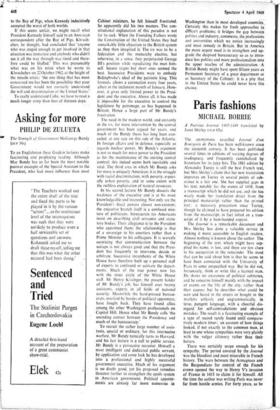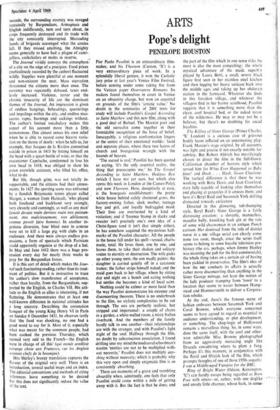Paris fashions
MICHAEL BORRIE
The anonymous so-called Journal d'un Bourgeois de Paris has been well-known since the sixteenth century. It has been published several times in editions of varying degrees of inadequacy, and frequently cannibalised by historians for its juicy bits. The 1881 edition by Alexandre Tuetey is still the best French text, but Mrs Shirley's claim that her new translation improves on Tuetey in several points of sub- stance is a fair one. She has supplied gaps in his text, notably for the events of 1438, from a manuscript which he did not use, and she has wisely made her translation direct from the principal manuscript rather than the printed text: a necessary precaution since Tuetey, though he claimed to have prepared his edition from the manuscript, in fact relied on a tran- script of it by a ham-handed copyist.
The Journal is a remarkable document and Mrs Shirley has done a valuable service in making it more accessible to English readers. Almost nothing is known about the author. The beginning of the text, which might have sup- plied his name, is lost, and there are few clues to his occupation in the remainder. The most that can be said about him is that he seems to have been connected with the University of Paris in some unspecified way. But he did not, fortunately, think or write like a learned man. He shows no awareness of political subtleties, and he concerns himself mainly with the impact of events on the life of the city. rather than their causes; but he describes what could be seen and heard in the streets or bought in the markets artlessly and ungrammatically, in terse, pungent language, with a cheerful dis- regard for self-contradictions and obvious mistakes. The result is a fascinating example of a type of record rarely found until compara- tively modern times: an account of how things looked, if not exactly to the common man, at least to one whose sympathies were very plainly with the vulgar citizenry rather than their betters.
There was certainly scope enough for his sympathy. The period covered by the Journal was the bloodiest and most miserable in French history. The wars between the Armagnacs and the Burgundians for control of the French crown opened the way to Henry V's invasion of France in 1415 to claim it for himself. All the time the author was writing Paris was never far from hostile armies. For forty years, as be records, the surrounding country was ravage:4 repeatedly by Burgundians, Armagnacs and English indifferently, turn and turn about, its crops frequently destroyed and its trade with the city constantly interrupted. Marauding bands of brigands scavenged what the armies left. If they missed anything, the Almighty seems generally to have had a plague of cater- pillars, cockchafers or moles in reserve.
The Journal vividly conveys the atmosphere, of a city on the edge of a precipice. Food prices (meticulously recorded by the author) fluctuated wildly. Supplies were plentiful at one moment and non-existent the next. Mass starvation
threatened the citizens more than once. The currency was ,repeatedly debased, taxes end-
lessly increased. Violence, terror and the chronic insecurity of life are the dominant themes of the Journal. An impression is given
of endless hangings, beheadings, quarterings and impalings within the city, and endless mas- sacres, rapes, burnings and sackings without. The author's limited vocabulary makes this aspect of his account more than a little., monotonous. One almost senses his own relief when he is able to record some bizarre varia- tion on the theme of death: when 'he tells us, for • example, that Jacques de la Riviere committed suicide in prison in 1413 by hitting himself on the head with a quart bottle of wine; or that the , executioner Capeluche, condemned to lose his own head in 1418, was obliged to show his green erstwhile assistant, who filled his office, what to do.
But life, though grim, was not totally in- supportable, and the citizens had their amuse- ments. In 1427 the sporting scene was enlivened by a fiendish Betjemanic tennis player called Margot, a woman from Hainault, 'who played both forehand and backhand very strongly, very Cleverly and cunningly, as well as any man' (jouoit devant main derriere main tres puissan- ment, n'es malicieusement, tres abillement, comme povoit faire homme). In another in- genious diversion, four blind men in armour were set to kill a large pig with clubs in an enclosure. And there were always endless pro- cessions, a form of spectacle which Parisians could apparently organise at the drop of a hat. In May and June 1412 there was ,a huge pro- cession every day for nearly three weeks to pray for the Burgundian forces.
It is this sort of detail which makes the Jour- .
nal such fascinating reading, rather than its treat- ment of politics. But it is instructive to trace the author's slow transference of acceptance, rather than loyalty, from the Burgundians, sup- ported by the English, to Charles VII. His atti- tude to the English as allies is interesting, if not flattering. He demonstrates that at least one well-known difference in national attitudes has a long ancestry. Describing the coronation banquet of the young King Henry VI in Paris on Sunday 6 December 1431, he observes tartly that 'the food was shocking, no one had a good word to say for it. Most of it, especially what was meant for the common people, had been conked the previous Thursday, which seemed very odd to the French—the English were in charge of all this' (qui moult sembloit estrange chose aux Francoys, car les Anglois estoient chefz de la besongne).
Mrs Shirley's breezy translation captures the flavour of the original very well. There is an introduction, several useful maps and an index. ) The editorial conventions and methods of citing references leave something to be desired but this does not significantly reduce the value of the text.



































 Previous page
Previous page